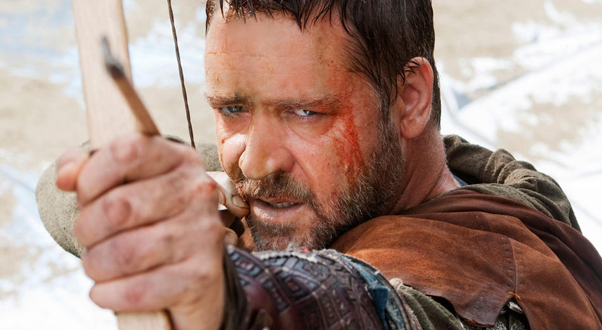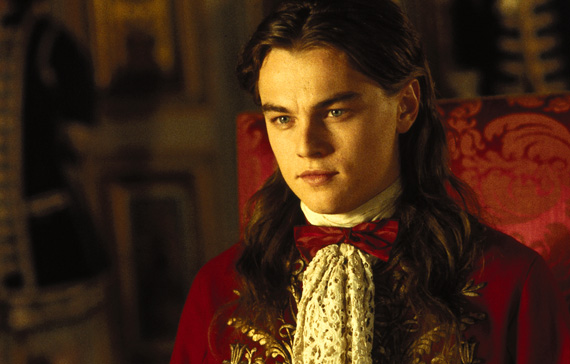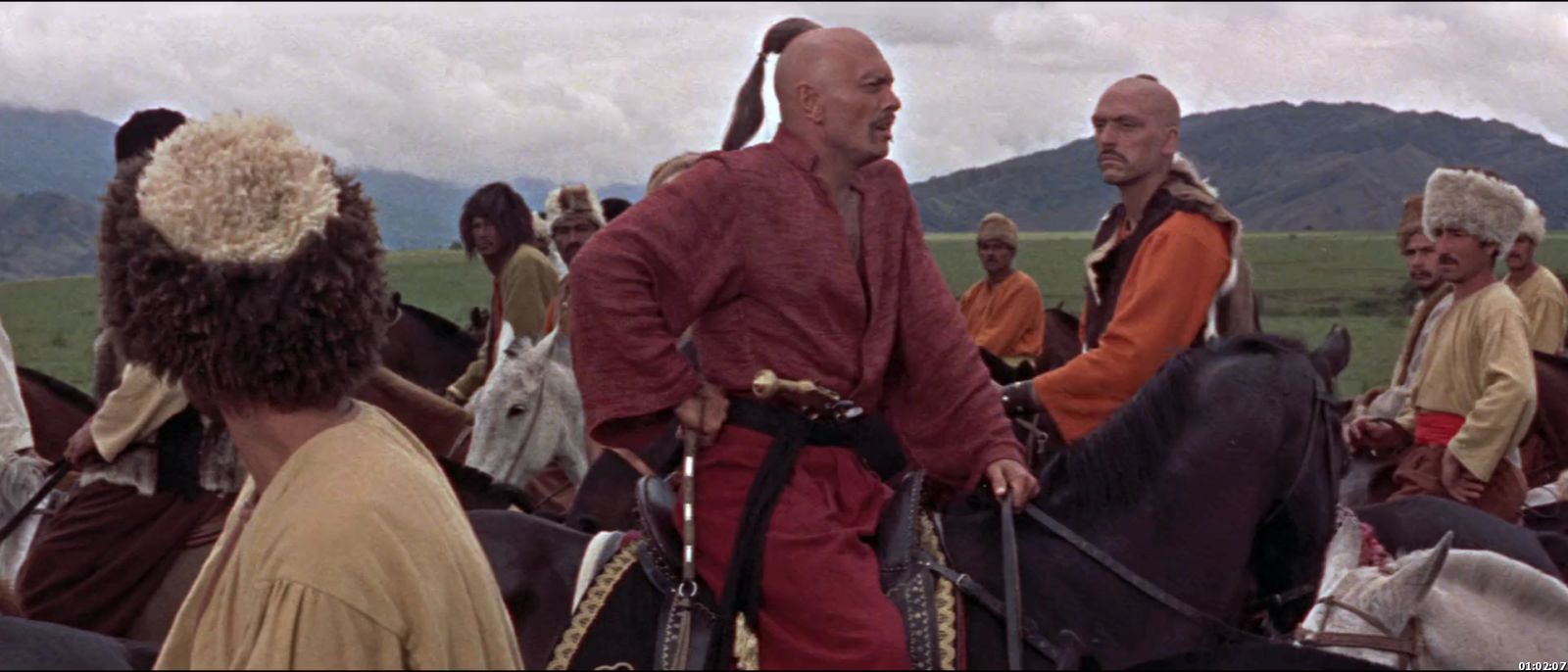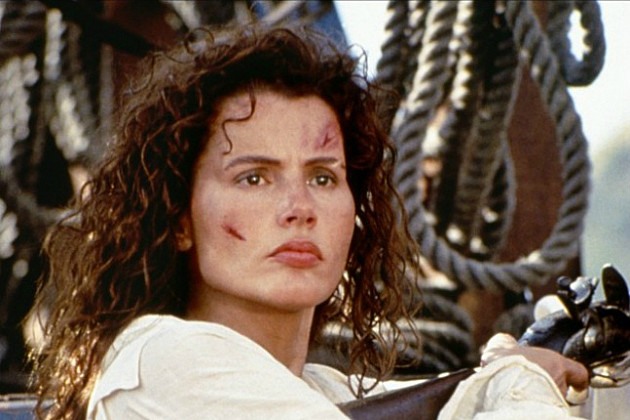5. Robin Hood (2010)

Another attempt to make a ‘realistic’ version of a legend is the 2010 version of Robin Hood. Unfortunately, it is rife with errors…the landing craft! Oh my!
There was a kind of ship before 1199 AD that could land mounted troops directly on to the beach. This was the tarida, a ship of Constantinople that could put about 15 mounted cataphracts onto the shore, when it backed up to the beach. It was a large, expensive ship, and the Eastern Empire only had a few of them. The specialized landing craft shown in this movie would never have existed.
Nothing so boxy could cross the English Channel in the first place, and in the second, how would they tow them across and then load them up from ships scarcely larger than the landing craft themselves? And in the third…who would waste all that money on specialized ships that were a single-use vessel? Especially on so many of them! At least ninety of these specialized ships can be seen, each one carrying around 50 troops including the rowers. Nobody would risk that many men on such unseaworthy ships.
Except Hollywood, of course. They had engines, so they cheated.
The helmets worn by the common soldiers in the movie were all correct for the period, but the nobles are all wearing helms from about 150 years later, and there are some silly, small mistakes, like calling King John majesty instead of grace.
The knights don’t carry lances for the most part. Why not? What use is a man on horseback without a lance?
England wasn’t famous for archers in 1199. They hired Welsh mercenary archers, who invented and used the longbow. It didn’t become an English thing until Edward I banned all other sport to make sure they had plenty of longbowmen available…after he conquered Wales.
So why do they spend so much time and effort on costumes, and trying to make a movie gritty and real, while not bothering to get obvious details right?
4. The Man in the Iron Mask (1998)

Let’s start by saying that Louis XIV was not a good king. He was magnificent and extravagant and flamboyant, and might’ve had as many children as Genghis Khan. However he did not ‘feed his people.’ He beggared the nation, and was much more responsible for the unrest that caused the French Revolution than his son or grandson.
In The Man in the Iron Mask, the costumes are good, everybody is dirty and unkempt, and the attitudes are completely weird. The whole series of The Three Musketeers is an 1840s reimagining of a novel from around 1700 written about the 1660s, so we shouldn’t be too harsh regarding factual errors of attitude…unless they’re from the 1990s, when this movie was made.
John Malkovich, who plays Athos in the film, is a very fine actor, but this movie makes the classic Hollywood mistake of personalizing everything. Athos was the Comte de la Fère, a nobleman of no small means, and had a very clear and firm sense of honor, which while not common to the time in question, was not unknown and was the ideal to which many aspired, but more failed to reach.
In the movie his motivations are entirely personal, and he has no real sense of honor. King Louis (played by Leonardo diCaprio) organizes his son’s death so he can get the girl, and so Athos decides to betray the king. If this story sounds familiar, then you probably have read the Bible, because it’s more David and Bathsheba and Uriah the Hittite than anything that happened in 17th century France. Uriah’s father also never vowed revenge against King David.
This idea that one could simply betray the king for personal reasons would’ve been seen as very weird in the 1660s. Charles I had been executed by the English parliament, but most of the great nobles fought on his behalf, because they had personal oaths to maintain. The Comte de la Fère would be one of those great nobles, with a personal oath to betray, and to do it because his son Raoul (played by Peter Sarsgaard) was killed in combat is not exactly appropriate to the time. In the movie Raoul’s death was not even quite so contrived as that of Uriah.
And let’s not even bother much with d’Artagnan being the father of Louis XIV and his twin brother. It makes as much sense as William Wallace being the father of Edward III, when Isabel married Edward II at the age of 12…after Wallace had already been dead for years. Hey, didn’t Randall Wallace write both this movie and Braveheart?
3. Taras Bulba (1962)

It’s hard not to like Taras Bulba, because how many other movies about the Cossacks even exist? This movie little resembles the book, nor does it much resemble the times. Some of the costumes are good, some terrible. Some of the attitudes and customs of the Cossacks are correct, and some are pure Hollywood.
One rather silly error is explosive shells in field artillery. Such things didn’t exist in the 17th century. Field artillery was extremely new-fangled, but explosive shells had a long time to go yet. This is one that Hollywood does all the time, because explosions are more fun than a cannonball rolling along the ground chopping men down.
While they did at least have a few Cossacks with scalp locks, almost none of them are correct. The scalp-lock hung from the front of the head, and was usually quite small, rather than being a long pony-tail on an otherwise bald head.
Tony Curtis, who plays Andrei Bulba, didn’t have to shave his head or even wear a fake bald head; he just had his regular 1960s haircut. Yul Brynner, who plays Taras Bulba, at least had a bald head, but he had quite the Chinese scalp-lock.
Even the weapons and armor don’t really fit the period. We’ve got Turkish and Arabic sabers rather than a Cossack shashka, and the Poles…the less said the better. To see more authentic Polish armor of the period, check out Day of the Siege (2012). It’s not as fun a movie as Taras Bulba, but it’s a lot more authentic.
2. The Scarlet Letter (1995)

Puritans have been much maligned by writers and actors since they came into existence, and few take much trouble to understand their ways or their history. The Scarlet Letter condemns them roundly, even more than the novel its based upon, and tells us that Hester Prynne (played by Demi Moore) was really a feminist hero after all.
This is a time when Daniel Defoe was writing to persuade people that it wasn’t dangerous to let women learn to read. A proud feminist slut arising in a tiny Puritan hamlet would’ve found herself on the scaffold, not shacking up with her nifty adulterous lover and love-child to find a better life.
Sex was not at all anathema to the Puritans; there are extant records of wives bringing their husbands to court to be reprimanded for not doing their duty in bed. The Salem Witch Trials were an aberration overall; most Puritan towns were very peaceful and witch hysteria barely ever cropped up.
While it might be fun to throw modern politics and attitudes into people who never heard of them, and would be horrified to learn that such things happen, it is extremely unrealistic and inauthentic. The story, possibly apocryphal, of Vikings killing a group of Arabs who enquired about their laws regarding pederasty because they came from a people where such things happened, is more appropriate to how a Cavalier would react to a present-day feminist, much less a Puritan!
1. Cutthroat Island (1995)

It’s rotten to pile on to one of the greatest movie flops in history, but that’s where we’re at.
Let’s start on the ships. Uglier ships rarely have appeared on film. Each one is a wallowing merchant vessel with not enough sail to be a pirate ship, because pirate ships tended to be smaller and faster than big ships made to carry lots of cargo. Didn’t pirates capture such ships and use them? They did indeed, but they only used them in convoy, with smaller or at the very least faster ships. What’s the point of having a ship that could never catch a prize?
In Taras Bulba the cannon fire explosive shells…so they do in Cutthroat Island. And not just exploding, big flaming explosions of gasoline burning on stone buildings. Sigh.
An example of how exploding shells affect naval warfare can be found in an excellent series of books by David Weber, the Safehold Series. Suffice it to say that explosive shells and wooden ships do not get on well together. And of course the cannon that fire explosive shells also have no recoil. Magic cannon!
Most insanely, they’re firing from on board ship at a town filled with innocents to destroy a carriage racing along the shore, and all they manage is to blow up a few buildings in the town, because of course the protagonists get away. I’m sure that lots of British naval officers in 1668 would think nothing of bombarding a British town to kill two fleeing suspects. Or, perhaps not. The British Navy was not at that time up to the professional standards that later characterized the service, but nobody is that unprofessional.
While we know there were real female pirates, such as Ann Bonny and Mary Read, in almost every case they hid their sex from most or all of the crew. According to Captain Charles Johnson in A General History of the Pirates, Bonny didn’t know Read was a woman, until both revealed themselves as women to each other. There is no historical example in the 1660s of a female pirate captain who lived openly as a woman…at least not in the West Indies. Geena Davis as Captain Morgan just didn’t come across as very credible, and gave us no reason to believe she could lead a crowd of cutthroats.
Of course it’s a fantasy, and that’s fine for movies, but at the very least there ought to be some reason for the crew to have a fanatic devotion to a female leader. Russell Crowe in Master and Commander manages to act as a leader of a ship, and it takes no great effort suspend disbelief and accept his acting, but Davis (or at least her character) doesn’t seem to have traits that would inspire any men of that time, but especially not pirates.
Maybe somebody could make a movie about Ann Bonny and Mary Read and ‘Calico Jack’ Rackham. Maybe it wouldn’t be one of the biggest box office disasters of all time.
Author Bio: James Wilson nerds for a living and writes in his spare time. He lives in the mountains of Arizona, well above the desert. His books and other writing may be found at www.sunderedpheres.com.